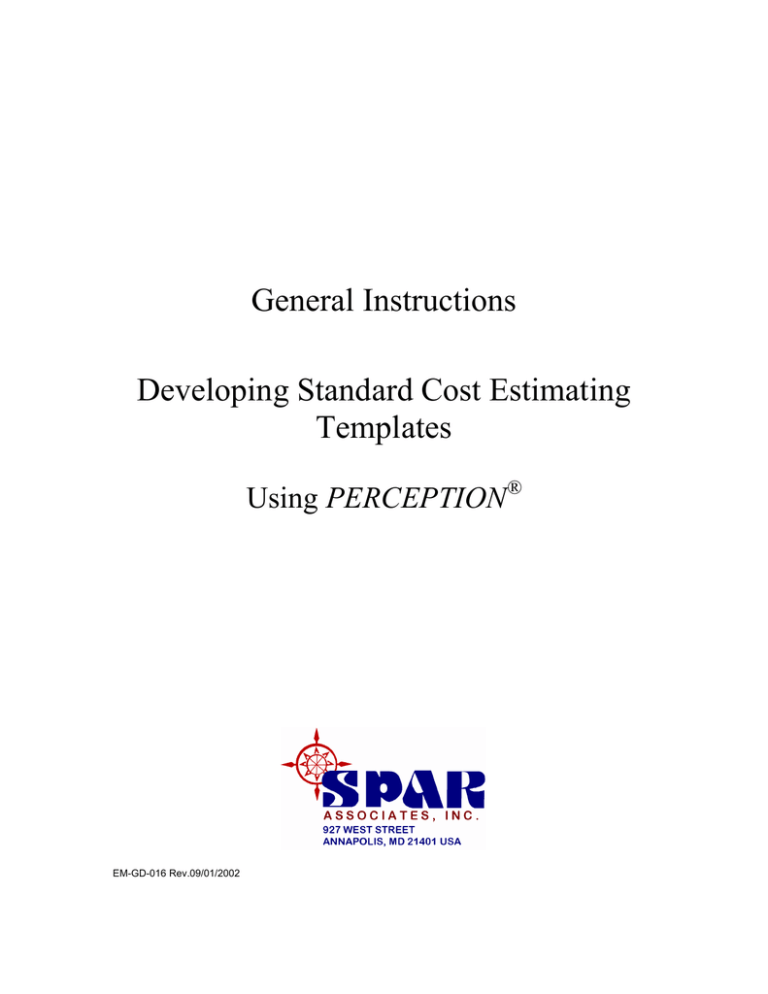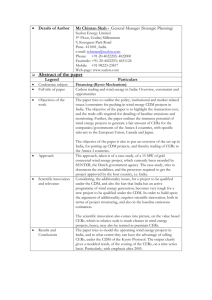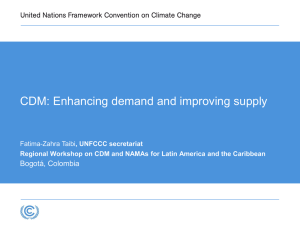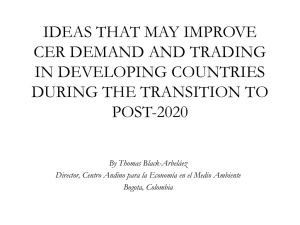
General Instructions
Developing Standard Cost Estimating
Templates
Using PERCEPTION®
EM-GD-016 Rev.09/01/2002
PERCEPTION is a registered trademark of SPAR Associates, Inc. ESTI-MATE, MAT-PAC,
WORK-PAC, and PERT-PAC are trademarks of SPAR.
“All Registered Trademarks used in this manual, whether marked as Trademarks or not
marked, are declared to belong to their rightful owner(s).”
PERCEPTION®
Trade Secrets and Proprietary Properties
Of
SPAR Associates, Inc.
Annapolis, MD 21401
NOTICE
The information contained in this document is subject to change without notice.
SPAR ASSOCIATES, INC. MAKES NO WARRANTY OF ANY KIND WITH REGARD
TO THIS MATERIAL, INCLUDING, BUT NOT LIMITED TO, THE IMPLIED
WARRANTIES OF MERCHANTABILITY AND FITNESS FOR A PARTICULAR
PURPOSE.
SPAR Associates, Inc. shall not be liable for errors contained herein or for incidental or
consequential damages in connection with the furnishing, performance or use of this
material.
This document contains proprietary information that is protected by copyright. All rights
reserved. No part of this document may be copied or distributed, transmitted, transcribed,
stored in any retrieval system, or translated into human or computer language, in any form
or by any means, electronic, mechanical, magnetic, manual, or otherwise, without the
express written permission of SPAR Associates, Inc.
NOTE: Any resemblance of costs shown in the following discussion with real costs
should be regarded as strictly coincidental.
Table Of Contents
CHAPTER 1: INTRODUCTION ................................................................................... 1
LIBRARIES & SOURCES OF COST ESTIMATING DATA ....................................................... 1
LIBRARIES OF STANDARD WORK PACKAGES ................................................................... 2
CHAPTER 2: EXAMPLE STANDARD PACKAGE (TEMPLATE)......................... 3
PACKAGE ITEMS USING LIBRARY CERS .......................................................................... 4
PACKAGE ITEMS USING STANDARD PARTS (STOCK & DIRECT PURCHASE) ..................... 7
CHAPTER 3: COPYING A STANDARD PACKAGE TO A PROJECT
ESTIMATE WORKSHEET ............................................................................................ 9
PROJECT WORK BREAKDOWN STRUCTURE (WBS) ASSIGNMENTS ................................ 11
WORK CENTER ASSIGNMENTS ....................................................................................... 12
CHAPTER 4: SAMPLE COST ESTIMATE REPORTS .......................................... 14
CHAPTER 5: TRANSFERRING COST ESTIMATE TO PRODUCTION
INFORMATION ............................................................................................................. 17
AUTOMATED GENERATION OF MATERIAL REQUISITIONS .............................................. 18
AUTOMATED GENERATION OF PRODUCTION WORK ORDERS ........................................ 20
CHAPTER 6: GENERATING PURCHASE ORDERS ............................................. 22
Chapter 1: Introduction
Cost estimating can be a tedious process and often fraught with opportunities to miss
important cost considerations. In addition, any way to quickly translate or convert the
cost estimate into useable production information is important. However, for such a
translation to be of much value the estimate must be reasonably complete and be to a
level of detail that can correlate reasonably well with actual costs collected during
contract execution. Tracking of actual costs against the estimate is a direct way to help
ensure that the estimate was both reasonably complete and a fair representation of the
actual costs. The tracking also enables any significant variances between the estimate
and the actual costs to be better recognized and enable future estimates to benefit from
this valuable feedback of information.
This document describes various methods available in the PERCEPTION system that
help ensure cost estimates are both accurate and complete. The discussions then proceed
to demonstrate how the cost estimate can be translated directly into production data:
material requisitions and production work orders. The material requisitions can be used
as the basis for purchase orders and for marshalling material for the production work
orders.
Libraries & Sources Of Cost Estimating Data
To help expedite and ensure that a cost estimate is complete, PERCEPTION’s cost
estimating module, ESTI-MATE™, provides the estimator with libraries of standard costs.
These libraries can be developed to accommodate a variety of cost information, including
the following:
•
•
•
Standard cost estimating relationships (CERs) cataloged by type of work;
structural, machinery, piping, electrical, HVAC, outfit, paint, and miscellaneous.
Standard material costs as maintained in the system’s Parts Catalog.
Standard work packages that enable multiple cost items to identify a range of
labor processes and material detail requirements.
In addition, the system enables the estimator to use cost estimate information from prior
estimates in whole or in part. Manual adjustments and vendor price quotations complete
the possible sources of cost information. All of these sources are available for use by the
estimator for any given bidding situation.
1
Libraries Of Standard Work Packages
This particular document focuses on developing standard cost estimating templates using
the standard work package facility available in ESTI-MATE. The work package can
utilize cost data from other cost libraries and there is considerable flexibility for the
estimator to formulate standard packages depending on the type of work involved in
them.
Typically, templates focus on one specific work type, although that is not a requirement.
Examples include dry-docking and pipe renewal for ship repair.
There are many ways to develop cost estimate templates. The following describes just
one approach that uses the re-usable interim product package for the template. The idea
for this package is to provide a full menu list of possible cost items that is complete with
the appropriate cost estimating relationships, or CERs.
2
Chapter 2: Example Standard Package (Template)
The following example develops templates for each type of pipe material and restricted to
a particular area of the ship (ship zone)1. In this way, the estimator can use one of these
templates when the type of pipe is known. Knowing where the pipe is located also is
likely to be important, as that will affect the scope of work involved. For example, pipe
renewal out on deck is easier and less costly than doing the work down in the double
bottoms.
The following figure 2-1 lists selections of pipe renewal templates (i.e., packages).
Figure 2-1: Pipe Renewal Packages (By Type Pipe & Ship Zone)
Within each package, the estimator may list as many different cost items as may be
needed for the template. Figure 2-2 list cost items and their related labor and material
CERs for each pipe size in the template. These items are restricted to carbon steel black
pipe, schedule 40 and for work done only on the weather deck. As listed in figure 2-1
above, other templates can be developed in a similar manner.
1
Productivity factors for where the work is performed also can be entered directly to cost items in the
project estimate worksheet.
3
Figure 2-2: Remove & Renew Standard Package Cost Items
The package items can have CERs defined either manually, or be linked to library CERs
and standard parts from the Parts Catalog. With library CERs, cost data can be managed
centrally regardless of where they are used in the system. The central management of
costs can be done using the Parts Catalog for material costs. Estimate items that link to
library CERs and to the Parts Catalog can be easily updated with a simple “rollup.”
The package items listed above in figure 2-2 use various CERs.
•
•
•
Library Pipe CERs (items #1-12)
Library Equation CERs (items #13-18)
Manual CERs (items #19-20)
CERs, whether from the libraries or manually entered for items can define labor and/or
material costs. Package items #1-18 use material costs from the Parts Catalog.
Note: Material CERS from the Parts Catalog always over-ride material CERs provided
either manually or from library CERs. The Parts Catalog has no influence on labor
CERs.
Package Items Using Library CERs
A selection of the package cost items is listed for work only on straight pipe. Figure 2-3
lists the library CERs for this work, and they are linked to package items that use them.
4
Figure 2-3: Remove & Renew Carbon Steel Black Pipe CERs (Straight Sections) On
Deck
Other items are for work on bent or shaped pipe. Figure 2-4 lists the library CERs for
this work.
Figure 2-4: Remove & Renew Carbon Steel Black Pipe CERs (Shaped Sections) On
Deck
In figure 2-4 above, the basis for the shaped pipe CERs is the same as for the straight
pipe CERs. The shaped CERs are increased 15% due to the added scope of work
involved using a “productivity factor” of 1.15. Figure 2-5 below lists the shaped pipe
CERs for the oil tanks and double bottoms. Work in these areas alone adds 25% more
work. A combined productivity factor for these CERs is 1.44 (=1.15 x 1.25). Note that
all these variations of CERS all are derived from the same baseline CERs of “W.DK”
and “STRAIGHT.”
5
Figure 2-5: Remove & Renew Carbon Steel Black Pipe CERs (Shaped Sections)
Tanks & Double Bottoms
Figure 2-2 package items #13-18 use Equation CERs. Figure 2-6 lists various equation
CERs. CERs numbered 2 and 3 use the ship characteristic of gross tons (GRT) as the
equation variable (an equation can be formulated with multiple variables).
A new feature of the system has been added so that equations can be developed not only
using ship characteristics as variables, but also the quantity as defined for the cost item
that uses the equation. The equation CERs numbered 4 -19 use cost item quantity
(“QTY!”) as its variable. These CERs develop labor CERs that are variable with pipe
length, the variable quantity input to these equations.
Figure 2-6: Sample List Of Equation CERs
6
The user can formulate the equation first by clicking on the Equation column data field.
This will open the equation window (figure 2-7) where the user constructs the equation in
the Define Expression box using whatever combination of keypad buttons (or direct input
from the key-board) and variables. The ship characteristics variables that are available
can be selected from the Characteristic drop-down list. The cost item quantity, identified
as QTY!, can be selected as a variable from the Thruput Variable drop-down list.
Figure 2-7: Formulating A CER Equation
Package Items Using Standard Parts (Stock & Direct Purchase)
When linking package items to standard parts in the Parts Catalog, the items will always
receive the current unit price as maintained in the catalog (figure 2-8). All cost estimate
reports will indicate material costs based on the unit purchase price. However, the formal
bid document, Customer Estimate Report, will use the retail price as maintained on the
Parts Catalog. The retail price, which is the unit purchase price adjusted by a markup
percentage, also will be used on the system’s Customer Billing Report.
7
Figure 2-8: Sample List Of Parts Catalog Of Pipe
8
Chapter 3: Copying A Standard Package To A Project Estimate
Worksheet
To copy a standard package into a project worksheet, the user must first open the project
cost item worksheet and click on the “Add IP package” button
on the toolbar. The
system then will copy all of the package items to the worksheet. Figure 3-1 shows the
wizard for copying one or more packages into the estimate worksheet.
Figure 3-1: Wizard To Copy Packages To Project Estimate
Figure 3-2 shows the resulting cost items copied from the package. If no cost item
quantities are defined in the package, the estimator must define the quantities in this
worksheet. Note that the items that use quantity as a variable in the CER equations
(items numbered 6 and 23) initially are set by the system to zero, since the initial quantity
is zero. When the estimator enters the quantity, the system will immediately compute the
CERs.
9
Figure 3-2: Estimate Cost Items After Packages Are Copied
When the estimator uses this package, all package item quantities may be pre-set to zero.
The estimator must enter the appropriate quantities to those items in the project estimate
worksheet that are required for the project. Items that are not needed can be deleted from
the worksheet. This process can be done easily first by clicking on the “Total Cost”
column heading so that the system will sort the worksheet items in ascending order of
total cost. The un-needed items will “float” to the top of the worksheet, and they can be
deleted as a group.
Cost items numbered 1-5 were created from another standard work package for drydocking. These items are linked to the specific ship’s set of design characteristics that are
shown in figure 3-3.
Figure 3-3: Sample Set Of Ship Characteristics Used For Selected Cost Items
10
Figure 3-4 shows the final list of estimate items after the quantities required have been
entered and those without quantities deleted.
Figure 3-4: Project Estimate Cost Items
Project Work Breakdown Structure (WBS) Assignments
The shipyard’s WBS can be defined on the package cost items so that the estimator does
not need to define it each and every time the package is used in an estimate. However,
cost items that are entered manually will need to be identified with the correct SWBS.
Figure 3-5 lists a sample SWBS set of WBS accounts.
Figure 3-5: Sample SWBS Accounts For A Project
Packages also may identify areas of ship. Using the PWBS ship zones provides this
information directly. Figure 3-6 lists a sample PWBS set of PWBS ship zones.
11
Figure 3-6: Sample PWBS Ship Zones For A Project
Work Center Assignments
Each and every cost item must be assigned to a shipyard work center. The work center
should at least identify the type work to be performed or the workshop normally
responsible for the work.
Figure 3-7 lists a sample set of shipyard work centers.
Figure 3-7: Sample List Of Shipyard Work Centers For A Project
Figure 3-8 shows a sample set of labor rates applicable to the work centers. Labor rates
can be made to vary from work center to work center and from project to project. The
rates can be defined across any number of applicable years.
12
Figure 3-8: Sample Work Center Labor Rates For A Project
13
Chapter 4: Sample Cost Estimate Reports
Figure 4-1 displays the total project cost estimate.
Figure 4-1: Total Project Cost Estimate
Figure 4-2 presents the cost item details for the estimate. This particular report sorts the
cost items by SWBS account. Other reports will sort this information by work center,
PWBS, etc.
14
Figure 4-2: Cost Item Detail Report (Sorted By SWBS Account)
Figure 4-3 presents the cost estimate summarized by SWBS account. Similar reports
summarize by work center, PWBS, etc.
Figure 4-3: Cost Summary Report (Sorted By SWBS Account)
15
The following figure 4-4 displays another report in a proposal format.
Figure 4-4: Sample Cost Estimate Proposal Document
16
Chapter 5: Transferring Cost Estimate To Production
Information
The system’s “tool box” provides for a wizard function that transfers cost estimate
information directly into production budgets, material requisitions and work orders.
Special Note: Prior to using this wizard, the user should always ensure that all cost items
have been correctly cataloged against the project WBS. This can be accomplished by
clicking on the “Validate Displayed Data” button
for the cost items displayed in the
project estimate worksheet. This is important, since only those cost items correctly
cataloged to the project WBS will be transferred to material requisitions and to work
orders.
Figure 5-1 shows the system wizard that makes this transfer from the estimate.
Figure 5-1: System Wizard Transferring Cost Estimate Data To Material Requisitions
And Work Orders
17
Note that the user has specified that the resulting labor budgets are reduced from the
estimate by 10% (labor management reserve), and that the resulting material budgets are
reduced from the estimate by 5% (material management reserve).
The following Figure 5-2 displays a summary of production budgets for the project.
Figure 5-2: Project Budget Summary
Automated Generation Of Material Requisitions
The system’s “tool box” wizard has the option to transfer cost estimate material
information directly into project material requisitions. The requisitions then may be
converted to purchase orders, as well as to production “pallets”.
This automated transfer function ensures that the material requirements of the cost
estimate are fully defined for the purchasing and material control processes of the
shipyard. These material requisitions may be modified to suit actual project requirements
and the automated requisitions may be regarded as a preliminary for general planning
purposes.
Special Note: Cost items like dry-docking that are based upon a standard fee should be
set with Part Type “Milestone Payment” so that they can be readily recognized as items
that are not purchased, but simply billed to the customer. The Part Type can be set either
on the standard package items or on the project estimate cost items.
18
The following Figure 5-3 displays the two requisitions that are created from the cost
estimate. A separate requisition is created for each SWBS account of the estimate.
Figure 5-3: List Of Automated Material Requisitions
The following figures 5-4a and 5-4b present the details of the first requisition. Figures 54c and 5-4d present the details of the second requisition.
Figure 5-4a: Requisition Header Information
Figure 5-4b: Requisition Detail Items Information
19
Figure 5-4c: Requisition Header Information
Figure 5-4d: Requisition Detail Items Information
Automated Generation Of Production Work Orders
The system’s “tool box” wizard also provides the option to transfer cost estimate labor
information directly into production work orders.
This automated transfer function ensures that the labor work requirements of the cost
estimate are fully defined for the production work centers of the shipyard. These work
orders may be modified to suit actual project requirements and the automated work
orders may be regarded as a preliminary for general planning purposes.
20
Figure 5-6 lists the seven work orders that are created from the cost estimate.
Figure 5-6: Listing Of Seven Work Orders Created From The Cost Estimate
Figure 5-7 displays the details of one of these work orders.
Figure 5-7: Details Of A Work Order Created From The Cost Estimate
21
Chapter 6: Generating Purchase Orders
Purchase orders may be generated directly from material requisitions. Figure 6-1
displays a collection of requisition items that are identified for a purchase order. By
clicking on the “Define Purchase Order” button
purchase order wizard, Figure 6-2.
the system presents to the user the
Figure 6-1: Collecting Requisition Items For A Purchase Order
Figure 6-2: The Purchase Order Wizard
Figure 6-3 displays the resulting purchase order. Note that PO item numbers 2 and 3
have consolidated quantity requirements of like parts to simplify the purchase order for
the vendor. This consolidation, however, does permit different delivery dates if
necessary.
22
Figure 6-3: Completed Purchase Order
23
Figure 6-4 displays the labor and material cost status for the project, summarized by
SWBS account. The labor hour budgets have been reduced from the estimate by 10%
and the material budgets have been reduced by 5%. After a material rollup has been
performed, the report also displays the commitment of the purchase order developed
(figure 6-3) against the project.
Figure 6-4: C7 Labor/Material Status Report By Project SWBS Account
24
SPAR Associates, Inc.
927 West Street
Annapolis, Maryland USA 21401
Phone: (410) 263-8593
Fax: (410) 267-0503
Email: Info@SPARUSA.com
Web Site: www.SPARUSA.com
25





